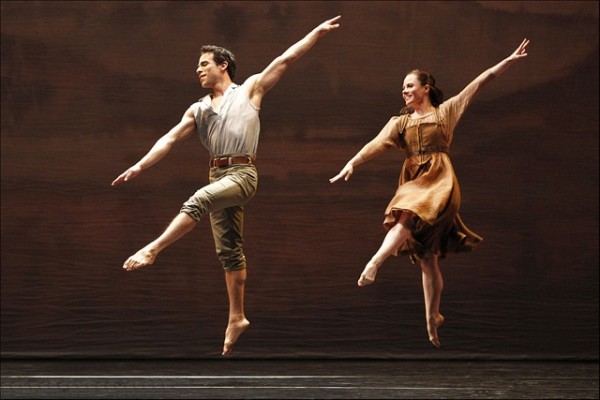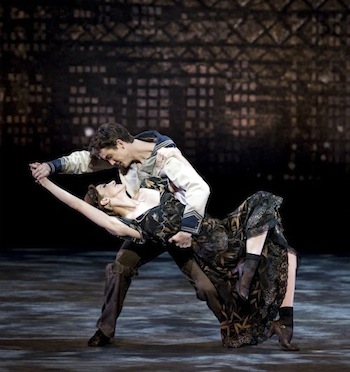Dance Review: The Paul Taylor Dance Company Continues to Startle and Engage
As might be expected from a choreographer who has created 140 dances, the varied program served as an annotated guide to Paul Taylor’s inquisitive and often dangerous imagination.
The Paul Taylor Dance Company, presented by the Celebrity Series of Boston at Shubert Theatre, Boston, MA, through November 3.
By Iris Fanger
Private Domain is the name of a mysterious dance that Paul Taylor choreographed in 1969, but also the title of the master-choreographer’s autobiography, published in 1987. Like the book, the work on stage hides as much as it delivers, but in a fascinating manner.
The Paul Taylor Dance Company’s program included “Perpetual Dawn” (2013), a local premiere; “Private Domain,” the centerpiece of the evening, and the lively “Black Tuesday” (2001), which is set to songs from the era of the Great Depression and costumed in period dress by Santo Loquasto, who also designed the stunning, changeable backdrop. As might be expected from a choreographer who has created 140 dances, the varied program served as an annotated guide to Taylor’s inquisitive and often dangerous imagination.
Two lines in a poem by Emily Dickinson suggested the title of “Perpetual Dawn” (music by the German baroque composer Johann David Heinichen): “For sunrise stopped upon the place, And fastened it in dawn.” Depicting a succession of young lovers in a sylvan landscape, the work is as lovely on the surface as any of Taylor’s other lyrical pieces that celebrate the human spirit at its sunniest. Despite the conventional romantic pairings, Taylor casts 13, not 12, dancers in the roles, so there’s always someone left without a partner. On Friday night, the outsider was Michelle Fleet, the only black dancer in the troupe that was brought to Boston. You might not notice the “ouch factor,” but with Taylor, a perfectionist, every detail is intended. Even in his most amusing or most beautiful works, there’s often something askew.
Otherwise, “Perpetual Dawn” is filled with dancers arranged in duets and triplets, moving in fast running entrances, sweeping through the stage space as they perform steps and lifts familiar from Tayor’s lexicon. There’s the jumping with legs in diamond shapes, the stag leaps, the sudden dives of a woman into the arms and then up onto the shoulders of a man, and the V-shaped arms that propel the bodies. These are signature moves the resonate with Taylor works of decades past. Watching them again is like welcoming a visit from old friends.
In contrast, “Private Domain” is dark, mysterious, and somewhat wanton. The dancers, the men dressed in briefs, the women in tiny pants and bras with midriffs bared, are partially blocked from view by two columns of fabric hung in front of the playing space, turning us into voyeurs forced to spy on the action. Their movements are clumsy, even heavy, framed deliberately by the column in ways that sometimes obscure the view: only parts of the bodies are visible. The women are often seen swinging their hips from side to side in a mock-burlesque fashon, or landing at the bottom of heaps of bodies on the floor.
The mood shifts to faux-Broadway musical for “Black Tuesday,” which comes off as if it was being performed by a disparate congregation of characters rendered homeless by the Depression. The work takes place in front of a backdrop depicting the metal arches of a train platform, the tracks sitting overhead. Later the scene is transformed into a night-time portrait of the New York skyline, the city’s windows alight. The final song, “Brother, Can You Spare A Dime,” is a heart-wrenching solo performed by Michael Trusnovec, a long time veteran of the company, beneath a starry, starry sky. A male duo performs a soft shoe number to “Underneath the Arches,” a routine that pokes sly humor at its location; the luscious red-head, Heather McGinley, rises and collapses to the rhythms of “The Boulevard of Broken Dreams,” while Jamie Rae Walker, a petite bombshell dressed as a boy, careens around the stage in fast tempo to “I Went Hunting and the Big Bad Wolf Was Dead.”
Taylor, the last of the legendary giants of 20th century American modern dance, continues to startle and engage 21st century audiences. He premiered his latest work a week ago in Philadelphia, and plans to start rehearsals on another piece with the company in December. We are lucky to be a witness to his achievements. Long may he wave!
Iris Fanger is a theater and dance critic based in Boston. She has written reviews and feature articles for the Boston Herald, Boston Phoenix, Christian Science Monitor, New York Times, and Patriot Ledger as well as for Dance Magazine and Dancing Times (London).
Former director of the Harvard Summer Dance Center, 1977-1995, she has taught at Lesley Graduate School and Tufts University, as well as Harvard and M.I.T. She received the 2005 Dance Champion Award from the Boston Dance Alliance and in 2008, the Outstanding Career Achievement Award from the Graduate School of Arts and Sciences at Tufts. She lectures widely on dance and theater history.


